

|


Snake Gourds
|
Hamsaduta: "No, he said, "I was able to get frozen vegetables from the south of Russia. They freeze it and then they sell it," he said, "but it is very expensive, very costly." He was getting frozen.
Prabhupada: That is also nasty. Frozen means nasty. I never take frozen. In the beginning I thought, "Oh, it is very nice, you can get fresh vegetable." But they are not at all fresh.
Hamsaduta: No.
Prabhupada: All rotten, rather the same vegetable, as we have got in India practice, we dry it and keep it. That is tasteful. In season time--suppose this season there is huge quantity of vegetable--so here the system is they cut into pieces during the season and dry it in the sun and keep it. And during out of season it is soaked in water, it revives the old taste, then you can cook. (Hindi or Bengali)
Devotee (1): Tastes as though it is different. The fresh vegetable the taste is very good.
Prabhupada: Fresh vegetable must be, but still there is some taste. But this frozen it has no taste.
Srila Prabhupada Room Conversation, 11-03-76, Vrindaban
|
Banana Flower (Kere, Kafool, Plantain Flower)
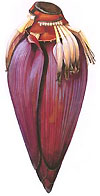
|
The deep purplish-crimson banana flower is used as a vegetable in Sri Lanka and across Southeast Asia. The flower is borne at the end of the stem, and is quite beautiful to behold. Long, slender, flowers are protected by large reddish bracts. To cook, remove and discard outer bracts until the inner, paler portion is revealed. Steam the whole blossom for 20 minutes or so, then use in whatever preparation you like.
|
Bitter Gourd (Kerala)
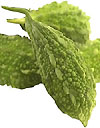
|
The Indian variety of bitter gourd is saw-toothed and the seeds are small and tightly packed in the flesh. As the name suggests, this is a very bitter vegetable that is an acquired taste for most. Lightly salt and drain the sliced and/or cored vegetable for an hour before using to reduce the bitterness. When bitter melons become ripe they turn orange and the seeds turn red, these ripe bitter melons are also eaten grilled and then mashed. Bitter melon is excellent as a digestive and blood cleanser.
Eating Bitter Melon the Bengali Way: As with all other bitter foods, bitter melon preparations are always eaten at the start of a Bengali meal with plain boiled rice. Serving bitter foods at the beginning of a meal helps get digestive juices flowing for the rest of the meal. Bengalis deep fry the bitter melon slices, add it to Moong dal, mix boiled bitter melon mashed with potato, and make the famous light stew of bitter melon and other vegetables known as "Shukto". Green bitter melons are also enjoyed as part of other vegetable.
|
Brinjal (Begun, Ravaya)

|
Eggplants come in all shapes, sizes and colors and are prized in the Indian kitchen. Easy to grow and great in everything from chutneys to curries, this is a staple vegetable. Eggplant is known in Hindi as baingan, in Indian-English as brinjals, and in England as aubergines. To prevent discoloration of the flesh while preparing brinjal, slice with a stainless steel knife and sprinkle with salt or lemon juice.
|
Capsicum (Simla mirich, Bari mirch)
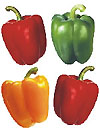
|
Capsicum also come in myriad different shapes, sizes and degrees of heat. Known as peppers, or chilies, the names used in different regions often indicate the level of hotness. Capsicum is often the name used for the large, mild varieties known as sweet peppers, bell peppers or banana peppers. Chilies are usually the hot ones… from medium hot to scorching!
Apply oil to your fingers and palms when cutting or slicing chillis as prevention against the burning sensation. It’s also helpful to de-seed chillis under a spray of water in a well-ventilated area. The burning sensation caused by handling chillis can be reduced considerably by washing the affected parts with sugar or tamarind. To prevent green chillies from turning red, keep them in a jar with a little turmeric powder sprinkled over them. In summer, buy green chillis in a large quantity. Blanch for 5 minutes and drain. Dry in the sun till crisp. Powder and keep in airtight containers. The powder comes in handy when fresh chillis are out of season. To keep green chillis fresh during summer, wash them in cold water, remove the stalks, place in cold water for 5 minutes, then wrap in a plastic bag.
|
Drum Stick (Muruggai, Sahijan, Sekta-ni-sing)
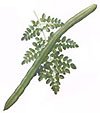
|
Sometimes referred to as a bean, this long, rigid pod grows on a tree rather than a vine. Its hard, green outer rind won it the name ‘drumstick’. Both pods and leaves are relished. The flavor of the pods has been compared with asparagus and the texture with marrow. Drum Sticks are a popular ingredient in vegetable curries. The only portion consumed is the soft, jelly-like interior in which seeds are embedded. The seeds are nice to eat if the beans are young, but never eat the outer skin. Simmer in lightly salted water for 7-10 minutes, scoop out the pulp, and discard the skin.
|
Bottle Gourd (Dudhi, Lauki)
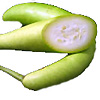
|
Only the youngest, tender Bottle Gourds are used in cooking. Prepare as you do any other gourd, peeling thinly and discarding the spongy middle and seeds. Its delicate nutty flavor is great in hot curries as well as cooling yogurt dishes. Use it like squash, but plan on the advantages of its firmer, crisper texture.
|
Cluster Beans (Gawar)
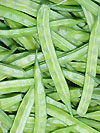
|
These crunchy beans are low in calories and popular throughout India. The plant is extremely hardy and grows easily even in drought-like conditions.
|
Okra (Bhindi, Bamia)
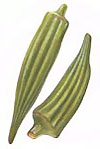
|
Okra is one of those vegetables people either love or hate. The slender pods are mostly emerald green, although there is also a pink variety. They contain small white seeds and have a rather peculiar furry exterior. Okra has a mucilaginous, or slimy quality, but it also has a wonderful, bright flavor when stuffed with spices and fried or cooked in sabjis. Just wash the pods and use whole. If the pods are very large, cut into bit-sized rounds.
|
Pumpkins (Bhopala)
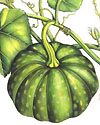
|
The pumpkin family includes a large number of vegetables and sweet melons, many of which do best in a warm climate. All grow on vines and have fruits which are watery and mild. Most are watery when cooked, and do best if the excess moisture is pressed out after steaming or baking, before they’re mixed with other ingredients.
|
Ridge Gourd (Todka, Torai, Jhingli)
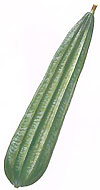
|
Also known as the silk gourd or luffa, this vegetable comes in a range of sizes. It’s distinctive ridges must be removed with a vegetable peeler, but in tender young gourds the rest of the green skin is left on and is edible. Sweet and mild in flavour, they’re wonderful in coconut milk based curries.
|
Snake Gourd (Padwal, Chichinda, Chirchira)

|
This bright green, thin-skinned gourd can grow to be quite large - as much as 6 feet in length. Gardeners often tie them to rocks, so they don’t curl too much. Snake gourds don’t have a great deal of flavor, but they’re very nice stuffed or chaunked with an assertive blend of spices.
|
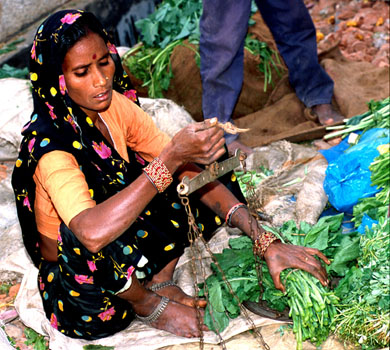
Taro (Alu Pan, Arvi, Patra)
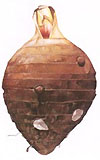
|
Taro is to the Pacific what potatoes are to Ireland - a staple food. There are many kinds of taro. The corms are the starchy staple, and taro leaves are also eaten, cooked like spinach. Steer clear of cooking and eating the whitish globules, which contain a substance that can be rather uncomfortable to chew and swallow.
|
Yuca (Cassava, Mogo, Mandioca)
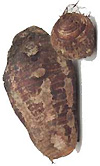
|
Yuca is dark brown in color, tapered at both ends, and usually between 1 to 3 pounds. Yuca’s are often waxed to seal in the freshness while at market. They’re tastier than a potato, and some of the tubers are even good eaten raw. To prepare, cut in two inch sections, then peel as the skin is often rather bitter. Fresh tubers can be hard to peel, so microwave them for a minute or two before hand. Yucas are good boiled, mashed, or cooked most ways potatoes are. They’re a great Ekadasi food, usually eaten in the form of tapioca.
|


|
|